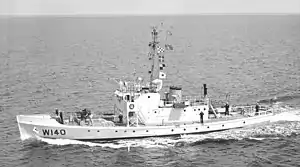 Active-class patrol boat General Greene, 1962 | |
| Class overview | |
|---|---|
| Name | Active class |
| Builders | American Brown Boveri Electric Corporation, Camden, New Jersey |
| Operators | |
| Built | 1926–1927 |
| In commission | 1927–1978 |
| Completed | 35 |
| Lost | 4 |
| Retired | 32 |
| Scrapped | 2 confirmed |
| Preserved | 2 |
| General characteristics | |
| Type | Patrol boat |
| Displacement | 232 long tons (236 t) |
| Length | 125 ft (38 m) |
| Beam | 23 ft 6 in (7.16 m) |
| Draft | 7 ft 6 in (2.29 m) |
| Propulsion | At launch: 2 × 6-cylinder, 300 hp (224 kW) Winton Model 114-6 diesel engines
1938: 2 x Cooper-Bessemer EN-9 600 bhp diesel engines 2 Propellers |
| Speed |
|
| Range |
|
| Boats & landing craft carried | As built: 2 20' Pulling Boats 1976: 1 14' Utility Boat |
| Complement | 1938: 22
1944: 38 1960: 3 officers, 17 men |
| Armament |
|
| Notes | 1 600-watt 12" spotlight |
The Active-class patrol boat was one of the most useful and long-lasting classes of United States Coast Guard cutters. Of the 35 built in the 1920s, 16 were still in service during the 1960s. The last to be decommissioned from active service was the Morris in 1970; the last in actual service was the Cuyahoga, which sank after an accidental collision in 1978.[1]
Design and construction
The Active-class was designed for trailing the "mother ships" along the outer line of patrol during Prohibition. They were constructed at a cost of $63,173 USD each ($979,038.74 in 2021 rates). They gained a reputation for durability that was only enhanced by their re-engined in the late 1930s; their original 6-cylinder Winton 114-6[2] diesels were replaced by significantly more powerful 8-cylinder units that used the original engine beds and gave the vessels an additional 3 knots.[1] They were meant to be able to stay at sea for long periods of time in any kind of weather, and were able to expand berthing space via hammocks if the need arises, such as if a large number of survivors were on board.[3]
Each ship was 125 feet [28.1 m] long, 23 feet 6 inches [7.1 m] wide, and had a draft of 7 feet 6 inches [2.1 m].[4]
Equipment
At launch, each cutter was fitted with a Winton Model 109 air compressor and Model 99 oil pump. A carbon dioxide fire suppression system was built by the Kidde Company, which in addition to water hoses powered by a seven and a half horsepower electric motors composed the ships' fire suppression. A 8,00-watt, 32 volt generator by the Hill Diesel Engine Company of Lansing, Michigan was driven by a 12 horsepower diesel engine which provided ship wide power.[2]
History
All the ships served in World War II, however the Jackson and Bedloe were lost in a storm in 1944. USCGC McLane is credited with the sinking of the inactive IJN submarine Ro-32.[5] Ten [Note 1] were refitted as buoy tenders between 1941 and 1942[6] and reverted to patrol work afterward.[1]
Originally designated WPC, (Coast Guard patrol craft), they were re-designated WSC, for Coast Guard sub chaser, in February 1942. The "W" appended to the SC (Sub Chaser) designation identified vessels as belonging to the U.S. Coast Guard. Those remaining in service in May 1966 were re-designated as medium endurance cutters, or WMEC.
The ships were informally nicknamed "Buck & a Quarters" in reference to their length, 100 feet (a buck, or $1.00) plus an additional 25 (A quarter, or 25 cents).[3]
Notable events
1944 sinking of Jackson and Bedloe
On 14 September 1944, USCGC Jackson (WSC-142) was instructed to rendezvous with the cutter USCGC Bedloe (WSC-128) and the tug USS Escape (ARS-6) to assist in the towing of the Liberty ship SS George Ade which had been torpedoed by the German submarine U-518 and driven ashore in a storm. After arriving in the area near the Outer Banks, weather conditions quickly deteriorated to hurricane conditions throughout the morning. Known as the Great Hurricane of 1944, the storm reportedly brought waves up to 100–125 feet (30–38 m) and 50-mile-per-hour winds. The ships were repeatedly thrown from the top of swells into the wave trough, causing heavy listing and impacting maneuverability and communications. At 10:30 AM Jackson capsized followed by Bedloe at 1:30. 37 crew members from Jackson and all 38 from Bedloe successfully made it off their ships, yet only 30 from Bedloe gained a hold on life rafts. High winds, waves, and sea pests hampered survival efforts as lifeboats were flipped and survivors scattered. The crews of both cutters believed they would be saved by the other, not knowing both ships had sunk. The lifeboats of Bedloe were spotted 51 hours after sinking and the Jackson's was seen 58 hours later. The rafts were spotted by a Coast Guard aircraft operating from Elizabeth City, North Carolina. Rescue aircraft began landing along with the crew members as the United States Navy blimps dropped emergency food and coordinated a rescue. A third 38-foot cutter from Oregon Inlet Lifeboat Station picked up survivors to be transferred to a navy minesweeper before being hospitalized at Norfolk, Virginia. 26 crew members from Bedloe and an additional 21 from Jackson died during the ordeal.[7][8] The original mission, to tow George Ade into port, succeeded in the sense that the ship suffered minimal damage and no casualties.[9]
1978 sinking of Cuyahoga
On 20 October 1978 USCGC Cuyahoga (WIX-157) was underway in the Chesapeake Bay to train officer cadets with intentions to turn into port for the night. The cutter was the oldest in-service ship in the Coast Guard's fleet and had fallen into a state of disrepair from lack of maintenance.[10] Natural low light levels made navigation harder with ships relying on signal lights for identification. The Cuyahoga was planning to turn into port when the lights of Argentine bulk cargo vessel M/V Santa Cruz II were spotted. The captain of the cutter considered the lights displayed to be that of a small fishing boat and failed to alter plans.[11] This belief was further aided by the radar showing a small contact at range.[10] The captain of Santa Cruz II believed the cutter would continue on course, allowing them to pass parallel to each other without incident. Cuyahoga believed the assumed smaller sailboat would see the large cutter turn and change course accordingly and committed to the plan. The Santa Cruz II sounded a whistle to notify that it would be the cutter's duty to maneuver out of a collision, yet received no response. It was only when a collision was inevitable that both captains realized the situation as a whole and attempted to respond. The Santa Cruz II sounded horns and signals, ordering all engines reversed and hard port while the cutter attempted to reverse. The two ships were too close to allow for any meaningful action. The bow of Santa Cruz II penetrated the starboard corner of the cutter's wheelhouse, cutting a three-foot hole in the hull as it moved aft at 2107 local time. A one-foot high by two-foot wide hole opened four feet below the waterline which doomed the ship.[11] The shock caused the Cuyahoga to tip 50 degrees to one side, throwing men and equipment overboard. Survivors were able to gain a hold on the 14 foot [4.2 m] utility boat which had broken off and risen to the surface.[10] The ship sank in 2 minutes, killing 11 of 29 crew members. The surviving 18 sailors were rescued by the Santa Cruz II. An official investigation by the U.S. Coast Guard blamed the collision on Cuyahoga's captain for his failure to correctly identify signal lights of the oncoming vessel and ensuing decision to turn into a path for collision as the reason.[11]
2021 sinking of Alert
It has been reported that the former USCGC Alert (WMEC-127) sank on 1 November 2021[12] west of the I5 Bridge in Portland, Oregon in the Columbia River after being moored off Hayden Island. The ship fell into disrepair after a homeless encampment moved onboard, hampering hopes for preservation.[13] The homeless groups and dock were removed December 2020, although officials had no long term plan for the ship as potential costs were too high.[12][14] The vessel was heavily damaged by graffiti and stripped parts. Although not fully sunk, a light on top of the pilothouse can be seen in images[12] as the ship rests in mud. No cause of sinking has been announced.
Ships preserved
- USCGC McLane is preserved at the Great Lakes Naval Memorial and Museum in Muskegon, Michigan.[15]
- USCGC Morris is preserved at the Liberty Maritime Museum in Sacramento, California.[16]
Ship naming
Each Active-class boat adopted the names of either officers or former cutters of the US Revenue Cutter Service, a predecessor of the Coast Guard.[2] Several names were new for the time, while a name such as the Alert has been on the sides of six cutters by 1927.[17] Most of the former cutters the boats were named after carried the name of a United States Secretary of the Treasury.[18]
Ships in class
| Ship name | Hull symbol | Yard number[19] | Slipway launched[19] | Laid down[19] | Launched[19] | Delivered[19] | Commissioned[20] | Decommissioned[20] | Fate[20][19] | Notes |
|---|---|---|---|---|---|---|---|---|---|---|
| Active | WPC-125 | #320 | L | 24 July 1926 | 30 November 1926 | 12 January 1927 | 30 November 1926 | 2 April 1962 | Sold, 6 September 1963 | Used as buoy tender between 1941 and 1942.[21] |
| WSC-125 | ||||||||||
| Agassiz | WSC-126 | #321 | 24 July 1926 | 30 November 1926 | 19 January 1927 | 20 January 1927 | 13 October 1969 | Sold, 16 October 1969 | Damaged in collision with MV Prince George off Cape Ann, 7 July 1928.[6] | |
| WMEC-126 | ||||||||||
| Alert | WSC-127 | #322 | 24 July 1926 | 30 November 1926 | 25 January 1927 | 27 January 1927 | 10 January 1969 | Sold, 6 October 1969
Museum ship before being abandoned and sinking on November 1, 2021, in Portland, Oregon |
||
| WMEC-127 | ||||||||||
| Antietam
Later renamed Bedloe |
WPC-128 | #323 | 24 July 1926 | 30 November 1926 | 22 January 1927 | January 1927 | n/a | Foundered in storm, 14 September 1944 | ||
| WSC-128 | ||||||||||
| Bonham | WPC-129 | #324 | 24 July 1926 | 30 November 1926 | 27 January 1927 | 29 January 1927 | 20 April 1959 | Sold, 30 December 1959 to Northland Marine Lines as Polar Star[19] Sold to Mark Benert Marine Services as Mindy B in 2005[19] | ||
| WSC-129 | ||||||||||
| Boutwell | WPC-130 | #325 | J | 28 August 1926 | 27 January 1927 | 8 February 1927 | 21 February 1927 | 7 May 1963 | Sold, 16 May 1964 as State Bell #296169[22] before becoming Rebel in 1972 and Activa in 1979[19] | |
| WSC-130 | ||||||||||
| Cahoone | WPC-131 | 28 August 1926[23] | 27 January 1927[23] | 21 February 1927 | 11 March 1968 | Sold, 12 December 1968 | ||||
| WSC-131 | ||||||||||
| WMEC-131 | ||||||||||
| Cartigan | WSC-132 | #327 | 28 August 1926 | 27 January 1927 | 2 March 1927 | 3 March 1927 | 12 October 1968 | Sold, 9 April 1969 to private owner for $26,000[24] Lifted for scrapping in 2004.[24] | Released 300 gallons of fuel oil in 2003 while berthed at New York City[24] | |
| WPC-132 | ||||||||||
| WMEC-132 | ||||||||||
| Montgomery
Later renamed Colfax |
WPC-133 | #340 | O | 4 December 1926 | 22 March 1927 | 4 April 1927 | 7 April 1927 | 9 November 1954 | Sold, 5 January 1956 as Colfax 271836 | Used as buoy tender between 1941 and 1942.[21] |
| WSC-133 | ||||||||||
| Crawford | WPC-134 | #328 | J | 28 August 1926 | 27 January 1926 | 17 February 1927 | 21 February 1927 | 15 August 1947 | Donated to Woods Hole Oceanographic Institution, 28 November 1955
Later sold to the University of Puerto Rico, 1970 Seized by USCGC Manitou (WPB-1302) for drug smuggling, 1986 Fate unknown |
Used as buoy tender between 1941 and 1942.[21] |
| WSC-134 | ||||||||||
| Diligence | WPC-135 | #330 | 28 August 1926 | 27 January 1927 | 18 February 1927 | 22 February 1927 | 30 September 1961 | Sold, 30 January 1963 | Used as buoy tender between 1941 and 1942.[21] | |
| WSC-135 | ||||||||||
| Dix | WPC-136 | #331 | M | 28 August 1926 | 27 January 1927 | 4 March 1927 | 5 March 1927 | 13 January 1948 | Sold, 16 June 1948 | |
| WSC-136 | ||||||||||
| Ewing | WPC-137 | #332 | L | 1 December 1926 | 15 March 1927 | 23 March 1927 | 26 March 1927 | 23 June 1967 | Sold, 23 January 1969 as Pacific Raider to Decorative Surfacing Centers Inc. Extant as Pacific Hunter as of 2019; renamed 1994[25] For sale at $124,000; moored at Ballard, California as of 2021 |
Lacked the single 3 inch gun at launch[26] Used as buoy tender between 1941 and 1942.[21] |
| WSC-137 | ||||||||||
| WMEC-137 | ||||||||||
| Faunce | WPC-138 | #333 | J | 1 December 1926 | 15 March 1927 | 29 March 1927 | 1 April 1927 | 13 January 1948 | Sold, 16 June 1948 to Humble Oil Refinery as Humble AC-2 #257810, then Myra White in 1961 and Vitow II in 1964 | |
| WSC-138 | ||||||||||
| Frederick Lee | WPC-139 | #334 | L | 1 December 1926 | 15 March 1927 | 2 April 1927 | 4 April 1927 | 15 December 1964 | Sold, 19 May 1966 as Virgil E #505701 | |
| WSC-139 | ||||||||||
| WMEC-139 | ||||||||||
| General Greene | WPC-140 | #335 | 2 December 1926 | 14 February 1927 | 15 March 1927 | 7 April 1927 | 15 November 1968 | Sold to Guatemala, 1976
Seized by the US Coast Guard for drug smuggling, 1979 Fate unknown |
||
| WSC-140 | ||||||||||
| WMEC-140 | ||||||||||
| Harriet Lane | WPC-141 | #319 | 24 July 1926 | 30 November 1926 | 31 December 1926 | 1 January 1927 | 29 April 1946 | Sold into merchant service and renamed MV Humble AC-4 #270632, 16 June 1948 to Humble Oil & Refining
Fate unknown |
Used as buoy tender between 1941 and 1942.[21] | |
| WSC-141 | ||||||||||
| Jackson | WPC-142 | #336 | 2 December 1926 | 4 February 1927 | 9 March 1927 | 14 March 1927 | n/a | Foundered in storm, 14 September 1944 | ||
| WSC-142 | ||||||||||
| Kimball | WPC-143 | #349 | 1 February 1927 | 25 April 1927 | 4 May 1927 | 7 May 1927 | 31 December 1968 | Sold, 24 February 1970 | Served as a training ship for the Merchant Marine Academy in 1939[6] | |
| WSC-143 | ||||||||||
| Legare | WPC-144 | #337 | 2 December 1926 | 14 February 1927 | 14 March 1927 | 17 March 1927 | 5 March 1968 | Sold, 29 November 1968
Fate unknown |
Used as buoy tender between 1941 and 1942.[21] | |
| WSC-144 | ||||||||||
| WMEC-144 | ||||||||||
| Marion | WPC-145 | #338 | O | 4 December 1926 | 15 March 1927 | 4 April 1927 | 6 April 1927 | 15 February 1962 | Sold into merchant service and renamed MV Top Cat, 8 March 1963
Fate unknown |
|
| WSC-145 | ||||||||||
| McLane | WPC-146 | #339 | 4 December 1926 | 22 March 1927 | 6 April 1927 | 8 March 1927 | 31 December 1968 | Used as buoy tender between 1941 and 1942.[21]
Sold, 14 November 1969 Museum ship in Muskegon, Michigan |
||
| WSC-146 | ||||||||||
| WMEC-146 | ||||||||||
| Morris | WPC-147 | #341 | 4 December 1926 | 4 April 1927 | 9 April 1927 | 19 April 1927 | 7 August 1971 | Sold, August 1970
Operated by the West Sacramento Sea Scouts from 1971[27] before being sold |
Lacked the single 3-inch gun at construction[26] | |
| WSC-147 | ||||||||||
| WMEC-147 | ||||||||||
| Nemaha | WPC-148 | #342 | 4 December 1926 | 4 April 1927 | 13 April 1927 | 19 April 1927 | 21 July 1947 | Sold, 14 June 1948[28] | ||
| WSC-148 | ||||||||||
| Pulaski | WPC-149 | #343 | 4 December 1926 | 4 April 1927 | 13 April 1927 | 30 April 1927 | 4 December 1946 | Sold, 14 July 1948 | ||
| WSC-149 | ||||||||||
| Reliance | WPC-150 | #344 | J | 1 February 1927 | 18 April 1927 | 22 April 1927 | 26 April 1927 | 11 March 1968 | Sold for scrap, 16 June 1948 | |
| WSC-150 | ||||||||||
| Rush | WPC-151 | #345 | 1 February 1927 | 18 April 1927 | 26 April 1927 | 27 April 1927 | 21 August 1947 | Sunk in collision with M/V J. A. Moffett Jr. in Ambrose Channel, 29 December 1927, later refloated[6]
Sold, 16 January 1948. Renamed Humble AC-1 with the Humble Oil & Refining Co. in 1949. Renamed Vitow I with Virgin Islands Towing Co in 1964.[29] |
||
| WSC-151 | ||||||||||
| Tiger | WPC-152 | #346 | 1 February 1927 | 18 April 1927 | 29 April 1927 | 3 May 1927 | 12 November 1947 | Sold, 14 June 1948 as Polar Merchant #257391
Completely stripped, 2018 serving as a floating hull at Tacoma, Washington.[30] |
||
| WSC-152 | ||||||||||
| Travis | WPC-153 | #347 | 1 February 1927 | 18 April 1927 | 26 April 1927 | 29 April 1927 | 5 June 1962 | Sold, 15 November 1962 as State Chief #294664 | Collided with M/V East Breeze off Halifax, Nova Scotia, 30 November 1944.[6] | |
| WSC-153 | ||||||||||
| Vigilant | WPC-154 | #348 | 1 February 1927 | 25 April 1927 | 29 April 1927 | 3 May 1927 | 9 November 1954 | Sold, 3 January 1956 as Vigilant #271208 | Used as buoy tender between 1941 and 1942.[21] | |
| WSC-154 | ||||||||||
| Woodbury | WPC-155 | #350 | L | 16 February 1927 | 2 May 1927 | 5 May 1927 | 11 May 1927 | 9 November 1954 | Sold, 3 January 1956
Renamed Humble AC-3 with Humble Oil Company as a tug. Renamed Challenge with Caribbean Towing Inc. where she serves to this day.[31] |
Used as buoy tender between 1941 and 1942.[21] |
| WSC-155 | ||||||||||
| Yeaton | WPC-156 | #351 | 16 February 1927 | 2 May 1927 | 7 May 1927 | 10 May 1927 | 18 May 1969 | Sold, 16 July 1970 | ||
| WSC-156 | ||||||||||
| WMEC-156 | ||||||||||
| Cuyahoga | WSC-157 | #329 | J | 28 August 1926 | 27 January 1926 | 17 February 1927 | 3 March 1927 | 3 November 1978
JSTOR |
Sunk in collision, 20 October 1978 Refloated, 29 October 1978
Scuttled, 29 March 1979 |
Transferred to United States Navy 29 May 1933, returned 17 May 1941 as AG-2. |
| AG-2 | ||||||||||
| WIX-157 |
Gallery
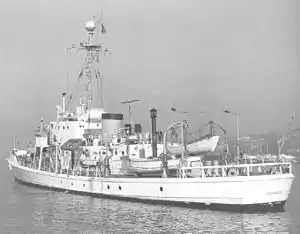
.jpg.webp) USCGC Faunce (WSC-138) in World War II camouflage
USCGC Faunce (WSC-138) in World War II camouflage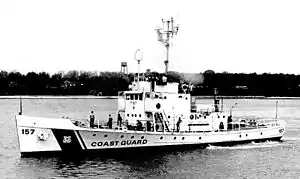
.png.webp) USCGC Agassiz in 1957 at Cape May, New Jersey.
USCGC Agassiz in 1957 at Cape May, New Jersey.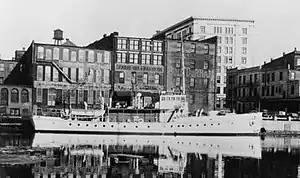 Cutter USCGC Antietam, later Bedloe (WSC-128). Date and location unknown
Cutter USCGC Antietam, later Bedloe (WSC-128). Date and location unknown The US Office of Naval Intelligence recognition image for the Active-class cutter during 1943.
The US Office of Naval Intelligence recognition image for the Active-class cutter during 1943..jpg.webp) USCGC Jackson on 31 March 1927 on the Delaware River
USCGC Jackson on 31 March 1927 on the Delaware River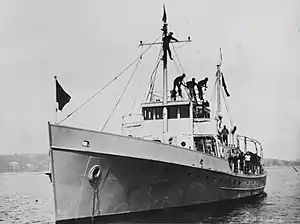 USCGC Active (WPC-125) participating in line-carrying experiments by aviation unit from Base 7, Gloucester, Massachusetts
USCGC Active (WPC-125) participating in line-carrying experiments by aviation unit from Base 7, Gloucester, Massachusetts Model of an Active-class cutter in its post World War II configuration
Model of an Active-class cutter in its post World War II configuration
Footnotes
[Note 1] The ten Actives used as buoy tenders were Active (WPC-125), Colfax (WPC-133), Crawford (WPC-134), Ewing (WPC-137), Harriet Lane (WPC-141), Legare (WPC-144), McLane (WPC-146), Vigilant (WPC-154), Diligence (WPC-135), and Woodbury (WPC-155).
References
Notes
- 1 2 3 "Comments and Corrections: Ask Infoser". Warship International. 42 (4): 423–438. 2005. ISSN 0043-0374. JSTOR 44893328.
- 1 2 3 Galecki, Bryan (2005). Rum Runners, U-boats, & Hurricanes: The Complete History of the Coast Guard Cutters Bedloe and Jackson. Pine Belt Publishing.
- 1 2 Jim Flynn (2012). "U. S. Coast Guard Patrol Craft - Major Classes" (PDF). 1: 11.
{{cite journal}}: Cite journal requires|journal=(help) - ↑ "Active, 1927 (WSC 125)". United States Coast Guard. Archived from the original on 1 October 2020. Retrieved 27 November 2021.
- ↑ "USCG Transports & Escorts: USS McLane (WSC-146)". www.ibiblio.org. Retrieved 9 December 2021.
- 1 2 3 4 5 Silvers, Paul. The Navy of World War II 1922-1947. Routledge.
- ↑ "Bedloe, 1927 (WSC 128)". United States Coast Guard. Archived from the original on 25 April 2021. Retrieved 15 November 2021.
- ↑ "USCGC Jackson | Monitor National Marine Sanctuary". monitor.noaa.gov. Retrieved 16 November 2021.
- ↑ The Coast Guard at War Lost Cutters VIII. Public Information Division, US Coast Guard Headquarters. 1947. p. 15.
- 1 2 3 Shomette, Donald (1982). Shipwrecks on the Chesapeake : maritime disasters on Chesapeake Bay and its tributaries, 1608-1978. Internet Archive. Centreville, Md. : Tidewater Publishers. ISBN 978-0-87033-283-8.
- 1 2 3 Coast Guard, Department of Transportation (13 November 1979). "Defense Technical Information Center" (PDF). Archived (PDF) from the original on 15 November 2021.
- 1 2 3 Staff, Newsroom (3 November 2021). "Abandoned former Coast Guard vessel sinks in Columbia River, costing taxpayers". KOBI-TV NBC5 / KOTI-TV NBC2. Retrieved 15 November 2021.
- ↑ English, Joseph (17 December 2020). "Crews clear 'Pirates of the Columbia' encampment". KATU. Retrieved 15 November 2021.
- ↑ "Oregon has no timeline for removing abandoned military vessels on Columbia River". kgw.com. 27 July 2021. Retrieved 15 November 2021.
- ↑ "USCGC McLane (WSC-146)". museumships.us. Retrieved 23 June 2019.
- ↑ "U.S. Coast Guard Cutter Morris". libertymaritime.com. Retrieved 29 December 2019.
- ↑ Canney, Donald (1995). U.S. Coast Guard and Revenue Cutters, 1790-1935. Naval Institute Press. p. 121.
- ↑ Canney, Donald (1995). U.S. Coast Guard and Revenue Cutters, 1790-1935. Naval Institute Press. pp. xvii.
- 1 2 3 4 5 6 7 8 9 "Comments and Corrections: Ask Infoser". Warship International. 55 (1): 23–25. 2018. ISSN 0043-0374. JSTOR 44894866.
- 1 2 3 Jim Flynn (2012). "U. S. Coast Guard Patrol Craft - Major Classes" (PDF). 1: 11–12.
{{cite journal}}: Cite journal requires|journal=(help) - 1 2 3 4 5 6 7 8 9 10 Silvers, Paul (2012). The Navy of World War II 1922-1947. Routledge. p. 358.
- ↑ Guard, United States Coast (1970). Merchant Vessels of the United States...: (including Yachts). U.S. Government Printing Office. p. 1168.
- 1 2 "USCGC Cahoone (WPC 131) of the United States Coast Guard - American Patrol vessel of the Active class - Allied Warships of WWII - uboat.net". uboat.net. Retrieved 12 December 2021.
- 1 2 3 Schedel, Charles W. (2003). "Ask Infoser". Warship International. 40 (4): 283–302. ISSN 0043-0374. JSTOR 44893060.
- ↑ "Pacific Hunter". ShipSpotting. 19 May 2015. Retrieved 2 November 2021.
- 1 2 Conway's All the World's Fighting Ships 1922-1946. London: Conway Maritime Press. 1980. p. 166. ISBN 978-0-85177-146-5 – via Internet Archive.
- ↑ "Tour the Sea Scout ship | The News-Ledger". www.westsac.com. Retrieved 11 October 2021.
- ↑ "Nemaha, 1927 (WSC-148)". United States Coast Guard. Retrieved 14 December 2021.
- ↑ "Rush (WSC-151) - Historical Collections of the Great Lakes". greatlakes.bgsu.edu. Retrieved 12 December 2021.
- ↑ Wong, Lui Kit (16 March 2018). "USCGC Tiger served at Pearl Harbor, used as floating hull at Tyee Marina". The News Tribune.
- ↑ "Woodbury, 1927". United States Coast Guard. Retrieved 12 January 2022.
Bibliography
Books
- Canney, Donald L. U.S. Coast Guard and Revenue cutters, 1790-1935. Annapolis, Md: Naval Institute Press, 1995. Print.
- Galecki, Bryan. Rum runners, U-boats, and hurricanes : the complete history of the Coast Guard cutters Bedloe and Jackson. Wilmington, N.C: Pine Belt Pub, 2005. Print.
- Gardiner, Robert, Przemysław Budzbon, and Robert Chesneau. Conway's All the World's Fighting Ships 1922-1946. Annapolis, Md: Naval Institute Press, 1984. Print.
- Shomette, Donald G. Shipwrecks on the Chesapeake : maritime disasters on Chesapeake Bay and its tributaries, 1608-1978. Centreville, Md: Tidewater Publishers, 1982. Print.
Journals
- Flynn, Jim; Lortz, Ed & Lukas, Holger (March 2018). "Answer 39/48". Warship International. LV (January 2018): 23–25. ISSN 0043-0374.
- Johnson, Harold (2005). "Question 57/02: ex-USCGC Cartigan". Warship International. XLII (4): 434. ISSN 0043-0374.
- Silverstone, Paul; Smith, Paul (2003). "Question 57/02: ex-USCGC Cartigan". Warship International. XL (4): 286–298. ISSN 0043-0374.
Websites
- "Active, 1927 (WSC 125)". United States Coast Guard. Retrieved 27 November 2021.
- "WPC125 Active Cutters (1927)". Retrieved 1 January 2012.
- "USCG Transports & Escorts: USS McLane (WSC-146)". www.ibiblio.org. Retrieved 9 December 2021.
- "USCGC Jackson | Monitor National Marine Sanctuary". monitor.noaa.gov. Retrieved 16 November 2021.
- "USCGC McLane (WSC-146)". museumships.us. Retrieved 23 June 2019.
- "U.S. Coast Guard Cutter Morris". libertymaritime.com. Retrieved 29 December 2019.
- "Bedloe, 1927 (WSC 128)". United States Coast Guard. Retrieved 15 November 2021.
- "PACIFIC HUNTER". ShipSpotting. 19 May 2015. Retrieved 2 November 2021.
- "Tour the Sea Scout ship | The News-Ledger". www.westsac.com. Retrieved 11 October 2021.
- "RUSH (WSC-151) - Historical Collections of the Great Lakes". greatlakes.bgsu.edu. Retrieved 12 December 2021.
- USCGC Cahoone (1927) at US Coast Guard Historian, which cites:
- Cutter History File. USCG Historian's Office, USCG HQ, Washington, D.C.
- Dictionary of American Naval Fighting Ships. Washington, DC: USGPO.
- Robert Scheina. U.S. Coast Guard Cutters & Craft of World War II. Annapolis, MD: Naval Institute Press, 1982.
- Robert Scheina. U.S. Coast Guard Cutters & Craft, 1946–1990. Annapolis, MD: Naval Institute Press, 1990.
- Rum Runners, U-Boats and Hurricanes: The Complete History of the Coast Guard Cutter Bedloe and Jackson.
- Brian Galecki, ISBN 9780976922308, Publisher: Pine Belt Publishing, Publication date:12/19/2005
Documents
The Coast Guard at War Lost Cutters VIII. Public Information Division, US Coast Guard Headquarters. 1947. p. 15.
News
"Oregon has no timeline for removing abandoned military vessels on Columbia River". kgw.com. 27 July 2021. Retrieved 15 November 2021.
Newsroom Staff (3 November 2021). "Abandoned former Coast Guard vessel sinks in Columbia River, costing taxpayers". KOBI-TV NBC5 / KOTI-TV NBC2. Retrieved 15 November 2021.
Wong, Lui Kit (16 March 2018). "USCGC Tiger served at Pearl Harbor, used as floating hull at Tyee Marina". The News Tribune. Retrieved 15 November 2021.
English, Joseph (17 December 2020). "Crews clear 'Pirates of the Columbia' encampment". KATU. Retrieved 15 November 2021.